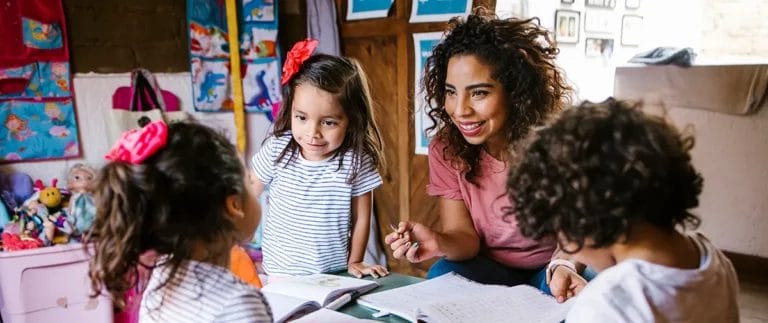Keeping your classroom running like a well-oiled machine is one of the most important things you do — students learn about 20% more in a positive, regulated environment. So why do only one-third of principals feel teachers are well-trained for classroom management challenges?
A National Council on Teacher Quality study found that less than half of teacher preparation programs effectively train new teachers in classroom management. Whether you went through a formal teacher training program or not, you may have a wealth of knowledge in your field but little classroom instruction in, well, classroom instruction.
Looking to add some tricks to your toolbox or learn effective classroom management strategies for new teachers? We asked educators from different subjects, settings, and grade levels to answer these questions:
What are the most important classroom management techniques
you had to learn through experience?
What tips do you have for putting common
classroom management strategies into practice?
But first, let’s get this important question out of the way.
What Is Classroom Management?
Classroom management refers to cultivating a climate where students can learn, contribute, and focus using a specific set of skills, tools, and techniques. Some sources slice those goals into the 3 Cs of classroom management: connection, consistency, and compassion.
The U.S. Department of Education’s Institute for Education Sciences highlights five key areas of evidence-based classroom management strategies:
- Establishing rules and routines
- Maximizing learning time
- Reinforcing positive behavior
- Redirecting off-task behavior
- Addressing serious misbehavior
But all beg the question: how do I put those ideals into practice?
We compiled teachers’ favorite tips and tricks in this desk-ready, downloadable infographic of effective classroom management strategies for new teachers. Let’s discuss how to use each tip in detail.

10 Must-Know Classroom Management Techniques According to Teachers
A kindergarten teacher and a physics professor might apply them differently, but these 10 themes came up repeatedly in our feedback from teachers. As we walk through practical advice for how to manage a classroom, consider ways to adapt these concepts for your students.
1. Set Consistent Expectations
It’s why you write rubrics, post classroom rules, and pass out a syllabus — letting students know what you want helps everyone work towards a common goal.
Take time at the start of the year or semester to explain your expectations and why they matter. Consider this: when you say “I allow students to revise and resubmit their work,” what you mean could be different than their last teacher. Even the most basic rules, like “be kind,” have many interpretations.
Once you have rules established, stick to them. Flexibility is important, but if you constantly bend your rules, students won’t be clear on what is and isn’t okay.
Marc, a 2nd-grade public school teacher, suggests consistency across all your teaching tasks, from dealing with disruptive behavior to setting a class schedule.
Follow through on what you say or kids will be confused about if you really mean it.
Kids also thrive on routine, so trying to keep a similar schedule each day helps them regulate their expectations. This is especially true of small kids who can’t tell time and only know how close they are to lunch or the end of the day based on where in the daily routine schedule they are.
2. Use Structure to Foster Engagement
Students with unstructured time will always find something to do. Keep it constructive by giving each student a specific task with a clear payoff or expected product.
For example, small group discussions could result in a group presentation, or students could digitally or verbally report their progress after scheduled work days for big projects.
Doug, a high school band teacher, shares how he keeps everyone involved during rehearsals.
Consistency + structure = student engagement.
Having clearly defined and consistently followed expectations makes it relatively easy for kids to step into an environment where they know unquestionably what is expected of them. Then, having components within that structure where every student is engaged and contributing means there is literally no time or opportunity for students to drift away and seem “unmanageable.”

3. Scaffold Your Lessons and Activities
Instructional scaffolding is the process of building up to complex concepts by learning supporting ideas first. Literacy teachers don’t ask students to read on day one. They systematically teach the alphabet, then the relationship between sounds and letters, and on down the line.
Intentionally breaking big ideas in bite-sized activities helps avoid leaving students behind. A student’s entire academic career is scaffolded — moving from one grade level’s standards to the next — but you can also scaffold units within your schedule and concepts within one session with careful lesson planning.
Shane, a college adjunct professor in English, explains how he scaffolds individual activities to build on each other within one class meeting.
I build my classroom experiences as a series of crescendos. They build upon the previous like waves coming into shore — opening journaling and discussion time feeds into the lecture, then the lecture feeds into small group discussions, then small groups feed into classroom discussions, and that finally leads into questions and homework.
It’s important to make sure that each section of class time has both a purpose and a payoff, and that students can see (even subconsciously) how they feed into one another. It keeps my students on task and allows me to expand/contract sections due to student questions or insecurities.
4. Let Students Demonstrate Knowledge in Many Ways
Teaching to include different learning styles is one of the signs of a great tutor or teacher, and it’s an integral part of how to manage a classroom. Students stay involved when they feel their learning process is valid.
An introverted student who never raises their hand in class may happily type insightful ideas into a collaborative brainstorming list in Google Docs. An auditory learner may struggle with research until you share notetaking methods for each learning style.
Halsey, a music therapist and private music teacher, recommends flexibility in checking for understanding.
Task, don’t ask — give students something to do to show they’re grasping concepts instead of only asking them to give an answer. It keeps them busy, avoids boredom, and helps them really soak up what they’re learning. It also lets them share their understanding with you in ways that make sense to them.

5. Praise in a Group and Correct in Private
It’s easy to lavish praise on a student’s assignment rubric where no one else will see, or snap at a misbehaving student in front of the class.
Try doing the reverse. Celebrate achievements (like a well-thought-out argument or leadership in a group project) publicly to build students’ confidence.
Conversely, avoid punishing or disrupting the whole class to deal with an individual issue. These are hard one-on-one conversations, but they’re more likely to address the underlying issue.
College film instructor Renee shares how compassionately addressing student behavior one-on-one led to a better learning outcome.
If I can help it, I don’t address a student’s behavior issue in front of other students. It makes an individual’s problem everybody’s problem and disrupts the whole class. Instead, taking a student aside privately to find out why they’re struggling helps get to the root of their issue, which might be fixable.
Once, an after-class talk revealed that a student who was struggling to stay awake and submit work in my class was the primary caregiver for a dying parent. That led to long nights and emotional exhaustion, which public shaming would not have fixed.
I couldn’t fix her situation either, but asking about it opened up a dialogue and let us work together to make it better. We were able to arrange her deadlines to fit around appointments (which, once adjusted, she met every time).
6. Give Students a Reason to Buy In
Students have plenty of long-term incentives to learn, but the joy of discovery and a fulfilling career are abstract concepts during the day-to-day slog. Effective classroom management means giving students a reason to invest their attention today.
This may look like giving younger students jobs like taking care of class pets, collecting papers, or being the official notetaker. For older students, establishing buy-in might mean offering assignment choices that reflect their career goals. You might even involve them in researching and teaching mini-lessons in their areas of interest.
Megan, a college Intermediate Writing instructor, uses this tactic to give students ownership over their learning:
I love giving students choices because I see writing class as a space for thinking and self-discovery. By encouraging students to choose paper topics that interest them and explore research from sources they enjoy, like YouTube, they’re starting with what feels relevant and engaging. I then help them learn how to sift through that information to find what’s academically solid and how to move into deeper levels of research.
When we discuss this deep research, I invite open feedback: What felt dry? What could have been presented better? This transparency helps them think critically about their preferences, equipping them to adapt their unique learning styles beyond the classroom.

7. Model the Behavior You Want to See
Frequently, you need to be the change you want to see in the classroom. Studies show teachers’ efforts to model respect, curiosity, preparation, and compassion pay big dividends for students as people and learners.
A joint Harvard and Brown study of math classrooms tested the impact of teacher behavior on student behavior. The strongest correlation it observed was between teachers’ emotional support (like regard for students’ perspective and creation of a positive climate) and students’ happiness in the classroom and self-efficacy in learning.
Classroom organization also had a strong effect on student behavior in class. If you’re prepared and focused, your students are more likely to be that way, too.
College adjunct English instructor Lindsey shared this tip for encouraging the understanding you want to receive by being the first to extend empathy to students.
We’re all human, including teachers. I always try to be empathetic and flexible whenever I can be. Illnesses, deaths, emergencies, and life in general can put a damper on schoolwork.
As long as a student shows me they’re dedicated and honestly putting in the work, I don’t mind bumping back a due date or offering some extra advice. In turn, if I get behind on grading or slip on entering a percentage in the grade book, I expect them to extend the same grace to me.
8. Try Not to Take It Personally
On the flip side, the way students act could have nothing to do with you. A hungry preschooler will be cranky regardless of whether your shapes lesson is fun and interactive. Tough home situations, big projects in other classes, and impending holidays can all take the focus off learning in your classroom.
New and veteran educators can easily fall victim to imposter syndrome, the feeling of being a fraud or unqualified. Effective classroom management is a marathon, so put more stake in overall engagement than in one failed activity. Patterns over time tell you more about whether a single event is problem behavior, a problem with your approach, or just a bad day. Effective classroom management goes beyond techniques and tools; it also involves creating a work-life balance that supports your well-being. Exploring the best states for teachers can help you find a place that aligns with both your professional goals and while also ensuring you bring your best to the classroom.
Alex, a middle school Teaching English as a Foreign Language (TEFL) teacher, encourages teachers to lean on their colleagues to gauge whether feelings fit reality.
I was teaching a class of 30 Korean middle schoolers right before a break and they were full of energy and super unruly. It was more difficult than usual to capture their attention and get them to care about English when all they wanted to do was talk to their friends about what they were gonna do once school was out.
At first, it was hard not to feel like they were intentionally disrespecting me, but sometimes you have to take a few seconds to remind yourself that they’d be doing this with any other teacher. And they were! When I went back to the teacher’s office afterward, all of my coworkers were lamenting how the students were checked out and making it hard to teach.
It’s not necessarily a you problem, and your fellow teachers will likely back you up on that.

9. Focus on Progress Over Achievement
How do you show students what success looks like? A Gates Foundation study found that how students view intelligence is a determining factor in their classroom performance.
Students who thought people were just born with intelligence (or not) tended to “feel dumb” when they didn’t grasp a concept right away. On the other hand, students who saw intelligence as earned with effort saw challenges and setbacks as opportunities.
Your students will bring one of these mindsets with them into your classroom. Encouraging a growth mindset can start with highlighting improvements besides grades.
Both TEFL teacher Alex and writing instructor Megan share their strategies for using small victories to help students build confidence and reach better outcomes over time.
Alex says:
My students in Korea felt a lot of pressure to speak English perfectly or not at all (especially in front of me as a native speaker). To get them more comfortable with speaking English to me and in front of their classmates, each student got a point card and could earn stamps for answering questions, participating in a speaking activity in front of the class, etc. After 20 stamps, they got a reward.
They didn’t have to pronounce everything perfectly, they didn’t need to get the grammar just right, they just had to be brave enough to try.
Megan says:
In my writing classes, I often spend a class period speaking about a growth mindset and assign post-paper reflections that encourage specificity and self-reflection. I’ll ask questions like:
“What specific part of this assignment did I struggle with the most, and how did I handle that struggle?”
“What feedback, either from the teacher, a classmate, or myself, was hardest to hear? How did I use that feedback?”
“What’s one risk I took in this assignment?”
“When did I feel proud of my work, even if it wasn’t perfect? What made me feel that way?”
Graded assignments are often difficult for students because, in some ways, they are exercises in emotional regulation — especially when feedback is given. Making students aware of what a growth vs fixed mindset is, then having them exercise those muscles, helps them to create a healthy relationship with criticism and become more self-compassionate in the process.

10. Know Your Students
Ultimately, all classroom management strategies are about supporting your students. Investing time into understanding them gives them a reason to believe that what you teach matters.
For example, make literary analysis relevant with inclusive reading assignments that will mirror your students’ lives and interests. Or offer the option to take an exam, deliver a presentation, or create an online mini-course for a history final.
If that sounds like more work for you, it is. Engaging with your students is time-consuming (and it’s guaranteed to make you feel old), but an invested adult who cares enough to ask about tryouts or chat about the book they’re reading can keep students checked in.
Lindsey, a college adjunct professor in English, also talked about how knowing your students plays into effective classroom management.
Students are people. It feels silly to say, but it’s an important reminder that all educators need. They have lives outside of my classroom, personal challenges, and preferences. Everybody needs different things to learn effectively. While the required learning outcomes can’t change, how we get there can.
Reading the group and the individuals is vital to having a successful class, and adapting to the students’ needs is one of the most important jobs a teacher needs to fulfill.
The Final Review: Embrace the Learning Process
The biggest secret of good classroom management techniques is that there isn’t one specific thing you need to do to be an effective teacher. Building an approach that sets you and your students up for success takes trial and error, so give yourself the same grace you extend to students as you polish and refine your skills.
Try out these tips this week, and talk to your favorite teachers to see what else they would add to our downloadable Classroom Management list.






